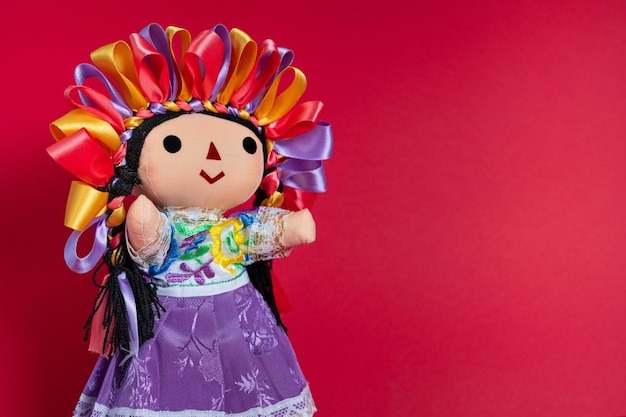

One of the most emblematic symbols of the state of Querétaro and Cultural Heritage of the state, this cloth doll, originally from the Magical Town of Amealco, has transcended its original function as a toy to become a true piece of art, which not only represents popular creativity, but also the identity of the artisans.
Lele, which in Otomí means “baby”, has its roots in the textile traditions of the Otomí and Pames peoples that inhabit the Sierra Gorda de Querétaro, a mountainous region with a rich cultural and artisanal history. Although there is no clear consensus on the exact date of their origin, it is known that these dolls have been made since colonial times and that they evolved over the centuries.
The creation of the doll is linked to indigenous women who, using ancestral embroidery and sewing techniques, wove these figures with natural materials such as cotton, wool and brightly colored threads. Traditionally, Lele dolls were handmade with care and skill, and each one carried a unique design, reflecting the craftswoman’s skill and creativity.
Today, it also has a strong symbolic charge. Influences from the indigenous cosmovision can be identified in its structure, with colors that represent elements of nature: red for the earth, green for plants and yellow for the sun. In addition, the dolls tend to have simple faces, often with symbolically painted eyes, which gives them a mysterious and spiritual air.
In some versions of the doll, her hair is made with threads that represent the fibers of corn, an essential crop for the native peoples of the region. Corn, as a symbol of life and sustenance, becomes a link between the doll and the identity of the people of Querétaro.
Over time, the Lele doll has also acquired great relevance in the field of cultural tourism. In various regional fairs and festivals, the doll is an object of attraction for visitors, who seek to take home a piece of Querétaro tradition. Its popularity has allowed many craftswomen to continue perfecting their techniques and continue producing Lele dolls for the national and international market.
In addition, the Ministry of Culture of Querétaro included it in its list of representative objects of the state, and its importance as a cultural element was highlighted in different events that promote the preservation of Mexican craft traditions, in fact, in the state of Querétaro, in the center of Amealco, is located the Museum of the Handmade Doll where more than 300 examples are exhibited.
Today, Lele dolls continue to be manufactured and marketed, not only as an element of artistic value, but also as a symbol of Querétaro identity. Artisans from communities such as Jalpan de Serra, Landa de Matamoros and other municipalities in the Sierra Gorda continue to make these dolls using techniques that have been perfected over the centuries.
Thanks to the #LelePorElMundo program launched in 2023, the doll toured several countries around the world and today is known and recognized for representing the strength of thousands of Mexican women.
And receive exclusive information to travel through Mexico in style!